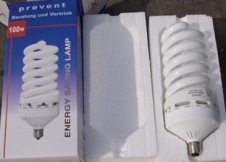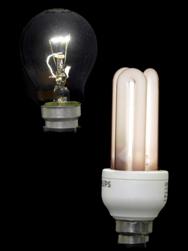Categories: Sharing experience, Interesting electrical news, Sources of light
Number of views: 72525
Comments on the article: 18
Advantages and disadvantages of energy-saving lamps
The economic calculation of the payback and economic efficiency of energy-saving (fluorescent) lamps.
 In Russia, every year more and more is not enough electricity. It is becoming increasingly difficult to obtain permission to connect industrial facilities and private households. According to the forecasts of power engineers, the doubling of electricity generation will occur no earlier than in 15 years. Therefore, electricity prices are constantly growing and will strive to reach the average European - 9 rubles / kWh.
In Russia, every year more and more is not enough electricity. It is becoming increasingly difficult to obtain permission to connect industrial facilities and private households. According to the forecasts of power engineers, the doubling of electricity generation will occur no earlier than in 15 years. Therefore, electricity prices are constantly growing and will strive to reach the average European - 9 rubles / kWh.
However, there is a fairly simple way to save energy and reduce the cost of its purchase. Experts have found that if in Moscow alone and only in apartments ordinary lamps are replaced with energy-saving, you can get energy savingequal to 30% capacity of Russia's largest Sayano-Shushenskaya hydroelectric station!
What energy-saving lamps? These are ordinary neon lamps, known since the last century. Previously, they were used in all plants and factories in pendant lights. Modern lamps differ in form factor and an integrated ballast.
Lamps have become more compact, suitable for any type of fixtures, turn on instantly, do not blink and do not buzz like old ones. The color of the lamps is characterized by the color temperature, measured in degrees Kelvin. Soft white - for home conditions 2700 K. Daytime - 4200K. Cold white - for warehouses 6400 K.
Energy-saving lamps have many advantages compared to conventional lamps (incandescent lamps). It:
2. Low heat dissipation (max. 50 C), they can be installed in plastic ceilings and fixtures;
3. Save energy and money up to 80%;
4. Long service life of 6000-12000 hours, which is 6-15 times more than ordinary lamps;
5. Soft light distribution;
6. The ability to create light of a different spectrum.
We estimate the cost savings from a single lamp with a power of 20 watts. It corresponds to the amount of light 100 W incandescent lamp. Take an operating time of 6000 hours, the electricity tariff is 2.90 r / kWh. Then the cost of electricity for an energy-saving lamp will be:
6000h x 0.02kW x 2.9r / kWh = 348 rub. according to 2009
For 100W incandescent bulbs:
6000h x 0.1kw x 2.9r / kWh = 1740 rub. according to 2009
One lamp, costing 120 rubles, for a lifetime gives a net profit of 1740 rubles - 348 rubles -120 rubles = 1272 rubles. And this is without taking into account the growth in the cost of electricity during the work (about 3 years)! And in your house you have at least 10 such lamps!
These lamps have some disadvantages:
1. The need for disposal, because lamps contain mercury;
2. They are more expensive - an ordinary lamp 10r, saving 120r.
However, in operation, energy-saving lamps bring profit and good mood.
The author was convinced of this by his own example, two years ago replacing all the lamps in the apartment with energy-saving ones. If you agree with your neighbors and buy such lamps in bulk, then twenty-one lamps will cost you 85-90 rubles. I wish you success and start saving and earning from yourself.
Read also on this topic: How are compact fluorescent lamps
See also at bgv.electricianexp.com
:

